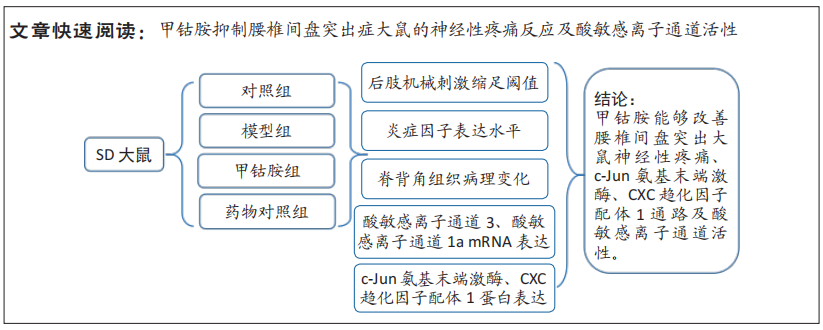中国组织工程研究 ›› 2023, Vol. 27 ›› Issue (17): 2658-2663.doi: 10.12307/2023.191
• 脊柱组织构建 spinal tissue construction • 上一篇
甲钴胺干预腰椎间盘突出症模型大鼠神经性疼痛及酸敏感离子通道的变化
王春宇1,陈志刚2,张建利1
- 1河北华北医疗集团峰峰总医院骨二科,河北省邯郸市 056200;2武警部队河北省总队医院外二科,河北省石家庄市 050081
Effects of mecobalamin on neuropathic pain and acid-sensing ion channels in a rat model of lumbar disc herniation
Wang Chunyu1, Chen Zhigang2, Zhang Jianli1
- 1Second Department of Orthopedics, Fengfeng General Hospital of Hebei North China Medical Group, Handan 056200, Hebei Province, China; 2Second Department of Surgery, Hebei Corps Hospital of Armed Police Forces, Shijiazhuang 050081, Hebei Province, China
摘要:

文题释义:
腰椎间盘突出症:主要是因为腰椎髓核、纤维环及软骨板等部位均有不同程度的退行性改变,并在外力作用下椎间盘纤维环破裂,髓核组织从破裂处突于后方/椎管内,引起相邻脊神经根被刺激进而导致腰痛或下肢麻木等。
甲钴胺:是维生素B12的衍生物,可参与DNA合成及蛋白质、脂肪代谢,并促进核酸、蛋白质合成等,可为轴突再生和神经组织修复提供良好的条件,是临床常用的营养神经药物,肌肉注射能直接将药物弥散至病变区域,发挥修复受损神经、重建神经功能的作用。
背景:酸敏感离子通道可参与突触可塑性、痛觉、触觉等多种生理过程,由于炎症导致的酸性微环境激活和改变可能是导致相关疾病迁延难愈和复发率高的重要因素。
目的:探究甲钴胺对腰椎间盘突出大鼠神经性疼痛、c-JNK、CXCL1通路及酸敏感离子通道的影响。
方法:选取健康SD大鼠40只随机分为对照组、模型组、甲钴胺组、药物对照组,每组10只。除健康组外其余大鼠均建立腰椎间盘突出模型,建模24 h后模型组及对照组腹腔注射0.8 mL/(kg·d)生理盐水,甲钴胺组予甲钴胺104 μg/(kg·d)腹腔注射,药物对照组采用塞来昔布
0.5 mL/(kg·d)腹腔注射,1次/d,所有组别均连续干预14 d。建模前1 d、建模后1 d及治疗7,14 d用智能热板仪对大鼠后肢进行机械刺激缩爪阈值测定;治疗7,14 d 以ELISA法检测炎性因子白细胞介素6、肿瘤坏死因子α;给药结束后24 h应用苏木精-伊红染色观察造模部位脊背角组织病理形态,PCR检测酸敏感离子通道mRNA表达,免疫印迹法检测c-Jun 氨基末端激酶、CXC趋化因子配体1蛋白表达。
结果与结论:①与对照组比较,模型组大鼠后肢机械刺激缩足阈值显著降低(P < 0.05);甲钴胺组后肢机械刺激缩足阈值高于模型组(P < 0.05),药物对照组低于甲钴胺组(P < 0.05);②与对照组比较,模型组白细胞介素6、肿瘤坏死因子α质量浓度升高(P < 0.05);甲钴胺组白细胞介素6、肿瘤坏死因子α质量浓度低于模型组(P < 0.05),药物对照组高于甲钴胺组(P < 0.05);③模型组神经元空泡样且不规则,核仁模糊、结构紊乱;甲钴胺组少量神经元固缩及核偏移,灰白质空洞样区域减小,核仁较为清晰,胞浆内尼氏小体较均匀;药物对照组仍有部分神经元固缩、坏死、溶解,灰白质空洞样改变区域减少;④与对照组比较,模型组大鼠脊髓背角组织中酸敏感离子通道3、酸敏感离子通道1a mRNA及c-Jun 氨基末端激酶、CXC趋化因子配体1蛋白表达水平升高(P < 0.05);与模型组比较,甲钴胺组上述指标表达水平降低(P < 0.05);与甲钴胺组比较,药物对照组上述指标表达水平升高(P < 0.05);⑤提示甲钴胺可抑制腰椎间盘突出大鼠神经性疼痛反应、血清中炎性因子表达及酸敏感离子通道活性,其机制可能与抑制c-Jun 氨基末端激酶、CXC趋化因子配体1相关。
https://orcid.org/0000-0003-1091-7261(王春宇)
中国组织工程研究杂志出版内容重点:组织构建;骨细胞;软骨细胞;细胞培养;成纤维细胞;血管内皮细胞;骨质疏松;组织工程
中图分类号: